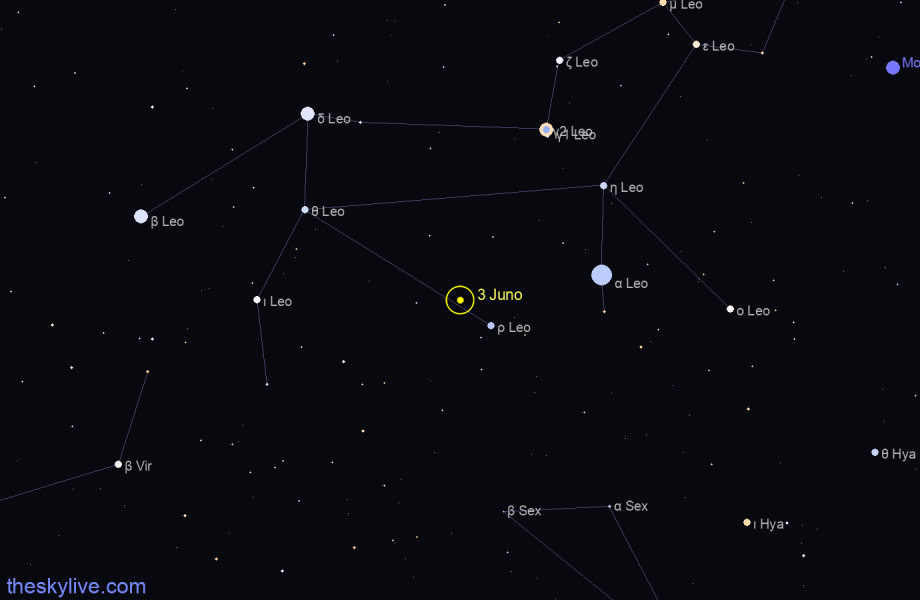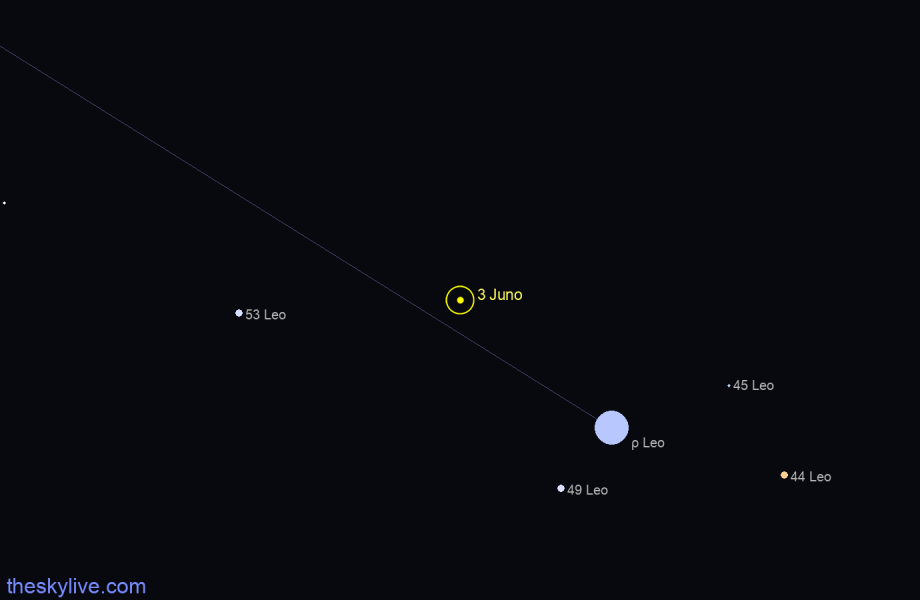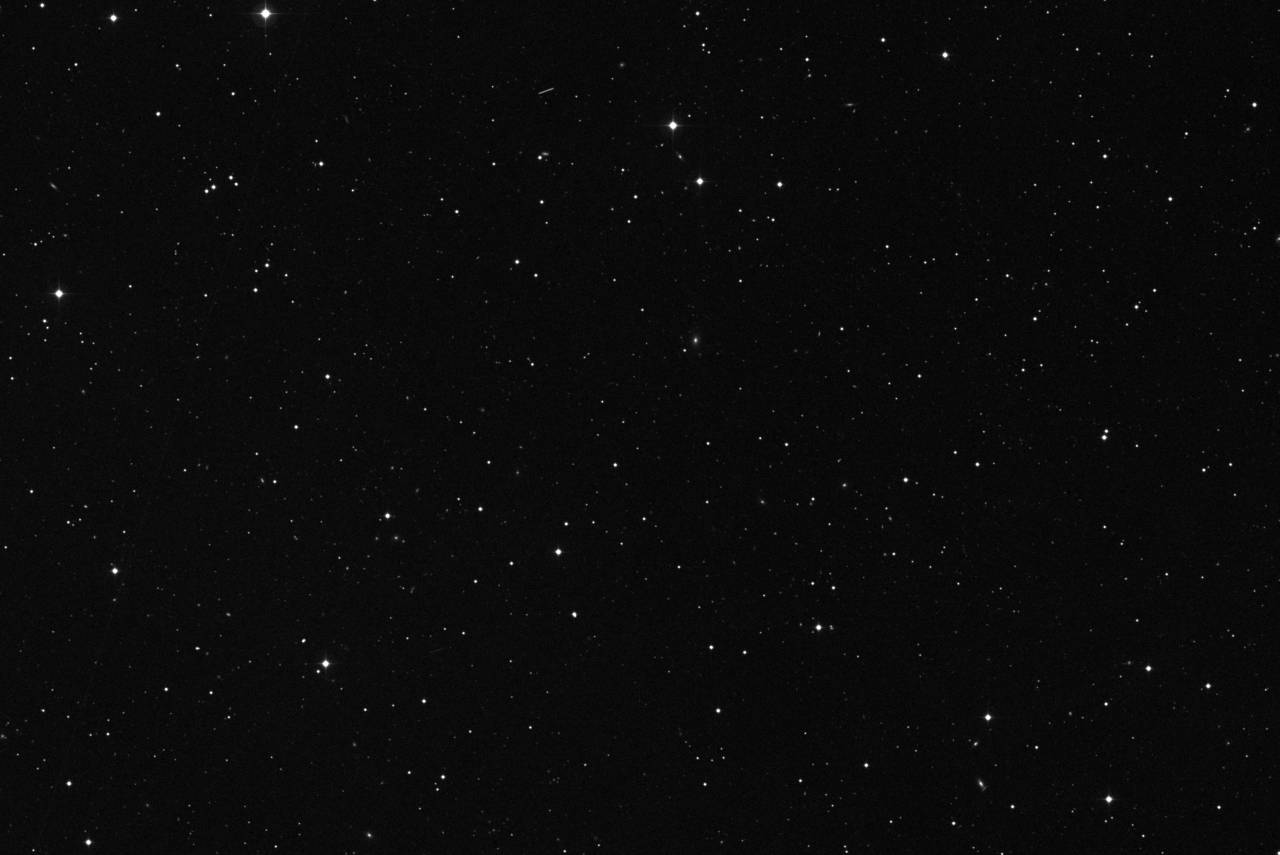Asteroid 3 Juno
3 Juno is a large main-belt asteroid located between the orbits of Mars and Jupiter. It was discovered on 1 September 1804 by German astronomer Karl Ludwig Harding and is one of the largest asteroids in the solar system, with a diameter of approximately 247 kilometers. Juno has an irregular shape, with a rotation period of about 7.2 hours, and its surface is covered in numerous impact craters, some of which are several kilometers in diameter. Juno's composition is thought to be a mixture of rock and metal, similar to the composition of the Earth's crust. Juno orbits the Sun once every 4.36 Earth years and has been observed by ground-based telescopes, as well as by the Hubble Space Telescope and the Dawn spacecraft. The observations have revealed insights into its geology, composition, and history, including potential signs of water and organic molecules on its surface.
Asteroid 3 Juno is currently in the constellation of Leo, at a distance of 322,605,181 kilometers from Earth.
View interactive star map
Today's rise, transit and set times of Asteroid 3 Juno from Greenwich, United Kingdom (all times relative to the local timezone Europe/London):
- 3 Juno is above the horizon from Greenwich, United Kingdom .
- Right now it is placed in the South-East direction at an altitude of 38° above the horizon.
- Given its current magnitude, 3 Juno is visible with the help of a binocular with a 60mm aperture, might require a small telescope.
- Go to interactive sky chart
If you need to access this information frequently for your observations, you can create a simple customized Quick Access page, so that you can easily bookmark it in your browser favorites or add a shortcut to your mobile phones' home screen.
Higher precision deep sky finder chart, 60 arcmin wide, showing where Asteroid 3 Juno is right now. Click on the image to see a more detailed fullscreen tracker view.
Also check out Where is Asteroid 3 Juno?, a page that provides all the information needed to find Asteroid 3 Juno in the sky and additional links to sky charts.
Asteroid 3 Juno Distance from Earth
The distance of Asteroid 3 Juno from Earth is currently 322,605,181 kilometers, equivalent to 2.156482 Astronomical Units. Light takes 17 minutes and 56.0951 seconds to travel from Asteroid 3 Juno and arrive to us.
The following chart shows the distance of Asteroid 3 Juno from Earth as a function of time. In the chart the distance data is measured in Astronomical Units and sampled with an interval of 1 day.
The value of the reported distance might be somewhat inaccurate around the times of closest approach for objects passing extremely close to Earth. The value of the distance of 3 Juno from Earth is also available as a real time updated value in the Live Position and Data Tracker.
Closest Approach of Asteroid 3 Juno to Earth
Between 1 January 1600 and 30 December 2499, the closest approach of Asteroid 3 Juno to Earth happens on Thu Nov 5 1874 at a distance of 1.028769 Astronomical Units, or 153,901,649 kilometers:
NOTE: values for the closest approach are computed with a sampling interval of 1 day.
Asteroid 3 Juno Brightness and Light Curve
The following chart is the predicted light curve (visual magnitude as a function of time) of Asteroid 3 Juno, according to the most recent ephemerides data. Magnitude data is sampled with a 2 days interval and there might be inaccuracies for objects changing brightness very rapidly during the course of a few days. For comets there could be large discrepancies between the observed and predicted brightness because of their highly dynamic behaviour.
Asteroid 3 Juno Orbital Elements
The following table lists the orbital elements of Asteroid 3 Juno at epoch 24 February 2023 00:00 UTC (JD: 2460000.5). Source: JPL Small-Body Database
| Element | Symbol | Value |
|---|---|---|
| Orbit eccentricity | e | 0.25646772 |
| Orbit inclination | i | 12.99066193° |
| Perihelion distance | q | 1.98533293 AU 297,001,580 km |
| Aphelion distance | Q |
3.35494071 AU 501,891,988 km |
| Semi-major axis | a |
2.67013682 AU 399,446,784 km |
| Orbital period | period |
4.3632 years 1,593.6711 days |
| Date of perihelion transit | Tp | 2023-Apr-02 04:38:39 2,460,036.6935 JD |
| Next perihelion transit | 2027-Aug-12 20:45 2,461,630.3646 JD |
|
| Argument of perihelion | peri | 247.73653371045° |
| Longitude of the ascending node | node | 169.84300685997° |
| Mean anomaly | M | 351.82411888186° |
| Mean motion | n | 0.22589353°/day |
Visualization of Asteroid 3 Juno Orbit
This 3d orbit diagram is a feature of our 3D Solar System Simulator and shows the orbit of Asteroid 3 Juno with respect of the Sun and the orbits of the major planets. The position of Asteroid 3 Juno and the planets along their orbits in this diagram accurately represents the current configuration of the objects in the Solar System. This is an experimental feature and it requires a WebGL enabled browser. Please provide us feedback!
View Asteroid 3 Juno in the 3D Solar System Simulator
Asteroid 3 Juno Physical Data
The following shows the known values of the most important physical parameters of Asteroid 3 Juno. Source: JPL Small-Body Database
| Physical Parameter | Value | Relative to Earth |
|---|---|---|
| Diameter | 233.92 km | 0.0184 |
| Sideral Rotation | 7.2100 hours | 0.3012 |
| Absolute Magnitude | 5.33 | |
| Geometric Albedo | 0.2383 |
Asteroid 3 Juno 15 Days Ephemeris
The following table lists the ephemerides of Asteroid 3 Juno computed for the past and next 7 days, with a 24 hours interval. Click on each row of the table to locate Asteroid 3 Juno in our Online Planetarium at the chosen date.
| Date | Right AscensionR.A. | DeclinationDec. | MagnitudeMag | Constellation |
|---|---|---|---|---|
| 2024 Apr 17 | 10h 32m 23s | +10° 00’ 24” | 9.64 | Leo |
| 2024 Apr 18 | 10h 32m 22s | +10° 04’ 12” | 9.66 | Leo |
| 2024 Apr 19 | 10h 32m 22s | +10° 07’ 49” | 9.69 | Leo |
| 2024 Apr 20 | 10h 32m 23s | +10° 11’ 13” | 9.71 | Leo |
| 2024 Apr 21 | 10h 32m 26s | +10° 14’ 29” | 9.73 | Leo |
| 2024 Apr 22 | 10h 32m 30s | +10° 17’ 31” | 9.75 | Leo |
| 2024 Apr 23 | 10h 32m 35s | +10° 20’ 25” | 9.77 | Leo |
| 2024 Apr 24 | 10h 32m 41s | +10° 23’ 07” | 9.79 | Leo |
| 2024 Apr 25 | 10h 32m 49s | +10° 25’ 37” | 9.81 | Leo |
| 2024 Apr 26 | 10h 32m 58s | +10° 27’ 59” | 9.83 | Leo |
| 2024 Apr 27 | 10h 33m 10s | +10° 30’ 08” | 9.85 | Leo |
| 2024 Apr 28 | 10h 33m 21s | +10° 32’ 08” | 9.87 | Leo |
| 2024 Apr 29 | 10h 33m 34s | +10° 33’ 59” | 9.89 | Leo |
| 2024 Apr 30 | 10h 33m 48s | +10° 35’ 38” | 9.91 | Leo |





